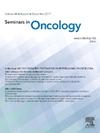Circular RNAs: Emerging regulators of signaling pathways in epithelial-mesenchymal transition and angiogenesis during breast cancer progression
IF 3
3区 医学
Q2 ONCOLOGY
引用次数: 0
Abstract
Circular RNAs (circRNAs) have emerged as important regulators of gene expression and cellular activities, and abnormalities in circRNAs in breast cancer have been linked to important biological processes like epithelial-mesenchymal transition (EMT) and angiogenesis, both essential for tumor metastasis. EMT facilitates the transition of epithelial cancer cells into a mesenchymal phenotype, enhancing their invasive and migratory capabilities, while angiogenesis promotes tumor progression by forming new blood vessels. CircRNAs also interact with microRNAs to regulate signaling pathways such as TGF-β, Wnt/-catenin, and VEGF. Besides EMT and angiogenesis, studies have identified that circRNAs affect metabolic reprogramming, chemoresistance, tumor microenvironment remodeling, and immunological evasion. Thus, circRNAs play a multifaceted role in the development of breast cancer. They hold potential as non-invasive biomarkers and therapeutic targets due to their high stability, resistance to exonuclease degradation, abundance in body fluids, and diverse expression patterns across different tissues. This review summarizes and critically assesses existing understanding of the functional roles and molecular processes of circRNAs in controlling EMT and angiogenesis during breast cancer progression.
环状rna:乳腺癌进展过程中上皮-间质转化和血管生成信号通路的新兴调控因子
环状rna (circRNAs)已成为基因表达和细胞活动的重要调节因子,乳腺癌中环状rna的异常与重要的生物学过程有关,如上皮-间质转化(EMT)和血管生成,两者都是肿瘤转移的必要条件。EMT促进上皮癌细胞向间充质表型转变,增强其侵袭和迁移能力,而血管生成通过形成新血管促进肿瘤进展。CircRNAs还与microrna相互作用,调节TGF-β、Wnt/-catenin和VEGF等信号通路。除了EMT和血管生成,研究还发现circRNAs影响代谢重编程、化疗耐药、肿瘤微环境重塑和免疫逃避。因此,环状rna在乳腺癌的发展中起着多方面的作用。由于其高稳定性、抗外切酶降解、在体液中的丰度以及在不同组织中的不同表达模式,它们具有作为非侵入性生物标志物和治疗靶点的潜力。这篇综述总结并批判性地评估了现有的circrna在乳腺癌进展过程中控制EMT和血管生成的功能作用和分子过程的理解。
本文章由计算机程序翻译,如有差异,请以英文原文为准。
求助全文
约1分钟内获得全文
求助全文
来源期刊

Seminars in oncology
医学-肿瘤学
CiteScore
6.60
自引率
0.00%
发文量
58
审稿时长
104 days
期刊介绍:
Seminars in Oncology brings you current, authoritative, and practical reviews of developments in the etiology, diagnosis and management of cancer. Each issue examines topics of clinical importance, with an emphasis on providing both the basic knowledge needed to better understand a topic as well as evidence-based opinions from leaders in the field. Seminars in Oncology also seeks to be a venue for sharing a diversity of opinions including those that might be considered "outside the box". We welcome a healthy and respectful exchange of opinions and urge you to approach us with your insights as well as suggestions of topics that you deem worthy of coverage. By helping the reader understand the basic biology and the therapy of cancer as they learn the nuances from experts, all in a journal that encourages the exchange of ideas we aim to help move the treatment of cancer forward.
 求助内容:
求助内容: 应助结果提醒方式:
应助结果提醒方式:


